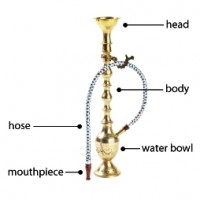25 Jan Hookah Bars Raise Secondhand Smoke Risks For Employees
MedicalResearch.com Interview with:

Dr. Terry Gordon
Terry Gordon, PhD
Professor, Department of Environmental Medicine
at NYU Langone Medical Center and at
New York University’s College of Global Public Health
Medical Research: What is the background for this study? What are the main findings?
Dr. Gordon:I t is well established that the intentional inhalation of tobacco combustion products causes severe respiratory and cardiovascular health effects and, in fact, active smoking is the leading preventable cause of death in the US and worldwide. Importantly, secondhand smoke exposure also causes a range of serious health problems in adults, adolescents, and children exposed in the home or at work. Secondhand smoke exposure can be as harmful as active smoking and is a major cause of both cancer and cardiovascular disease itself, as well as having countless other harmful effects. It was the scientific findings of these effects that led to many clean air regulations across the nation and enabled the FDA to regulate a number of tobacco products. A growing number of studies in the U.S. and abroad have demonstrated poor indoor air quality in hookah bars, but none have looked at the effect of this on those who work in such establishments.
We, therefore, studied whether workplace exposure to secondhand hookah smoke affects the pulmonary and cardiovascular systems. One of our main findings was that occupational exposure to secondhand hookah smoke produces systemic effects as seen by increases in inflammatory cytokines in the blood after a 10 to 12 hour work shift. This is very worrisome as more and more diseases are being linked to chronic inflammation. Changes in heart rate suggested that the cardiovascular system was also altered during a single work shift. The most dramatic effect, however, appeared to be an increase in exhaled carbon monoxide after the work shift. The low temperature burning of charcoal used to heat the shisha in a water pipe produces large amounts of carbon monoxide, and we observed exhaled carbon monoxide levels as high as 90 ppm, which suggests significant exposure of workers to secondhand hookah smoke and the potential for impairment of hemoglobin to efficiently carry oxygen to the tissues.
Medical Research: What should clinicians and patients take away from your report?
Dr. Gordon: Despite the widespread ban on cigarette smoking in public places, clinicians should be aware that significant exposure to toxic gases and particles still occurs in hospitality venues where hookah water pipe smoking is permitted. The spread of hookah bars in NYC and other urban centers in the U.S. continues and therefore the adverse respiratory and cardiovascular effects associated with the tobacco combustion products produced by hookah water pipes should be considered. The public must be informed of this, and counseling by clinicians and broader public education efforts are clearly needed.

Typical Hookah Pipe
Medical Research: What recommendations do you have for future research as a result of this study?
Response: As cigarette smoking declines, the use of alternative tobacco products is emerging. There is a misperception that hookah water pipe smoke is safer than cigarette smoke, perhaps because it is bubbled through water during smoking. In some cities, the ban on cigarette smoking has been extended to hookah lounges, but in other cities hookah lounge smoking is permitted if the shisha used in the water pipes does not contain tobacco products. Because the inhalation of the combustion products of plant material is generally deleterious to one’s health, additional research is needed to compare the adverse effects of tobacco-based vs. non-tobacco-based shisha used in water pipes. More importantly, although researchers have begun to provide clear evidence of acute adverse effects associated with hookah smoking, there has been little to no research on the chronic effects of this emerging health hazard. Moreover, it is not clear how many and who smoke hookahs at home, and how this might affect home indoor air quality and the health of those exposed.
Citation:
Sherry Zhou et al. Secondhand hookah smoke: an occupational hazard for hookah bar employees. Tobacco Control, January 2016 DOI:10.1136/tobaccocontrol-2015-052505
[wysija_form id=”5″]
Terry Gordon, PhD (2016). Hookah Bars Raise Secondhand Smoke Risks For Employees
[wysija_form id=”5″]
Last Updated on January 25, 2016 by Marie Benz MD FAAD
